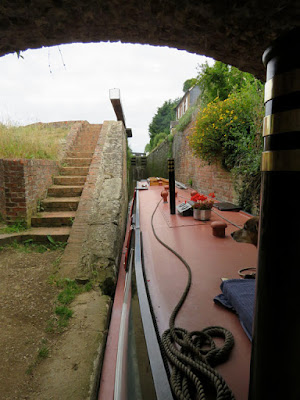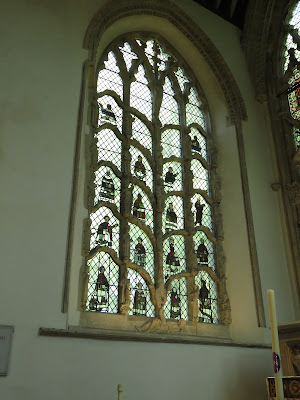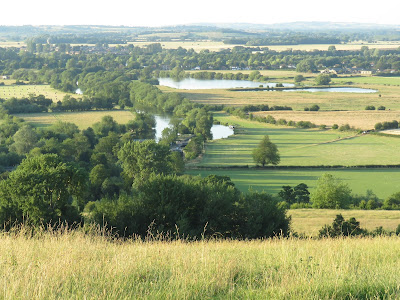 |
| Ugly chipboard walls hide the glorious Italianate church |
The great and good of the Canal and River Trust convened a meeting on the towpath outside Nb Harry yesterday and Seadog Brian decided they needed a good barracking. So as they listened to a talk from an Oxford historian about the local area of Jericho he set up a chorus of his best yapping from the boat.
Still, it gave us a chance to meet CART Chairman Tony Hales – affable chap that he is – and earwig the talk. So what were the top brass doing here? It seems there's a Board of CART Trustees meeting today. This time round it's in Oxford and wherever they meet they like to have a pre-event tour of the local canal scene. It's possibly the only time some of them get to see a canal, he added unkindly.
 |
| The Trustees of CART on their guided visit to Jericho |
Well they couldn't have chosen a more interesting – or contentious – spot than here. We are outside the walls of Jericho and, just as in the Old Testament tale, those walls are soon going to be knocked down.
And it won't be a moment too soon. The ugly chipboard walls that run along the canalside, hiding the remarkable St Barnabas Church from full view have been there for ten years now as reminders of the long and acrimonious battle to redevelop the old Jericho Wharf and its surroundings – a battle that included occupation of the boatyard site by protesters, one developer going bust and two plans being rejected by the council.
 |
| And when the walls are down, this is what is planned |
Finally, a plan by owners SIAHAF, a company that specialises in turning round and developing unusual sites, has been approved. It includes a community centre and community boatyard, houses, an open piazza revealing the church and a new bridge across the canal.
And very nice it all looks too in the artist's impression though quite why a community where tiny terraced houses now sell for half a million quid needs its own boatyard I'm not sure.
So what will boaters see when the church is revealed? A pretty special place, I think. Even half hidden it looks impressive but almost freakish, like something arrived from an Italian city not a parish church on the corner of Canal Street. Its huge tower dominates the local skyline.
The style of the church came about because its founders, Thomas Combe,
who was 'printer to the university' and his wife Martha, were both
ardent supporters of the Pre-Raphaelites as well as members of the
Oxford Movement who wanted the Church of England to return to some of
the Catholic traditions (including highly decorative churches).
It was built in the 1870s to serve the workers at Oxford University Press who mostly lived in the developing Jericho streets and able to hold up to 1000 people which gives you some idea of the number of workers there and the popularity – if that's the word – of churchgoing.
 |
| The spectacular interior of St Barnabas |
 |
| Richly decorated pulpit |
 |
| Exquisite wall tiling |
But if the exterior is impressive, the interior is eye-opening. It's a huge, open plan space (all the seating is removeable) and gloriously decorated with extravagantly painted panels, beautiful tiling and a painted, vaulted roof all in a romantic, Pre-Raphaelite and Arts and Crafts styles. Not surprisingly, the building is Grade One listed.
As if that wasn't enough culture for the day, I spent the afternoon at the Ashmolean Museum. (Look, I'm a boater and it's free so I'll go there!). The place is huge; five massive floors of art and artefacts, from the ancient world to modern art.
 |
| An Egyptian mummy in all its various casings |
To be honest, it was really too big; too big to take in on one two-hour visit. After a while After a while Sumerians, Minoans, Cretans, Moguls and Romans start to blur as you gaze at yet another display of pottery fragments, cuniform writing or ceremonial swords. Let alone the case upon case of Worcester porcelain.
 |
| A thousand pieces of Worcester porcelain are here |
 |
| Wall covering belonging to Pocohontas's father |
I opted for the 'ten highlights in an hour' route through the floors and managed to see a disparate range of stuff from Lawrence of Arabia's robe to various Egyptian mummies to a wall covering that belonged to Pocohontas's father and the King Alfred Jewel.
 |
| Lawrence of Arabia's impressive robe |
Oddly enough, the highlights didn't include a very well endowed little fellow called 'Jack of Hilton' who, the caption coyly explained 'performed an important function in an annual ritual involving a goose'.
 |
| And this naughty little fellow! |
Today we head out of Oxford and a return trip is already in our minds – to see Jericho and its church when the walls have come tumbling down.





















































